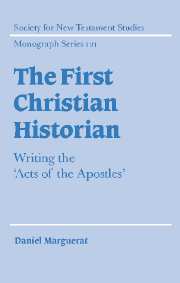Book contents
- Frontmatter
- Contents
- Preface
- 1 How Luke wrote history
- 2 A narrative of beginnings
- 3 The unity of Luke–Acts: the task of reading
- 4 A Christianity between Jerusalem and Rome
- 5 The God of Acts
- 6 The work of the Spirit
- 7 Jews and Christians in conflict
- 8 Ananias and Sapphira (Acts 5. 1–11): the original sin
- 9 Saul's conversion (Acts 9; 22; 26)
- 10 The enigma of the end of Acts (28. 16–31)
- 11 Travels and travellers
- Bibliography
- Index of passages
1 - How Luke wrote history
Published online by Cambridge University Press: 22 September 2009
- Frontmatter
- Contents
- Preface
- 1 How Luke wrote history
- 2 A narrative of beginnings
- 3 The unity of Luke–Acts: the task of reading
- 4 A Christianity between Jerusalem and Rome
- 5 The God of Acts
- 6 The work of the Spirit
- 7 Jews and Christians in conflict
- 8 Ananias and Sapphira (Acts 5. 1–11): the original sin
- 9 Saul's conversion (Acts 9; 22; 26)
- 10 The enigma of the end of Acts (28. 16–31)
- 11 Travels and travellers
- Bibliography
- Index of passages
Summary
Was the first historian of Christianity a proper historian?
There is no doubt that Luke – for this is what we name the anonymous author of the third gospel and the book of Acts – intended to tell a story about the birth of Christianity. He was the first to have written a biography of Jesus followed by what was later given the title of ‘Acts of Apostles’ (Πράξεις ἀποστολω̂ν). In antiquity, this would never be repeated. The two volumes of this grand work were divided at the time of the constitution of the canon of the New Testament, before the year AD 200; the first volume was grouped with Matthew, Mark and John to form the fourfold Gospel; the second work was placed at the head of the epistles, to establish the narrative framework of the Pauline writings.
It is here, at the moment when the corpus of Christian literature begins to emerge, that Luke's writing, dedicated to the ‘most excellent Theophilus’ (Luke 1. 3; Acts 1. 1), was broken in two. The length of the whole is impressive. These fifty-two chapters represent a quarter of the New Testament. Modern exegesis refers to this text as Luke–Acts in order to remind readers that Acts cannot be read without remembering the gospel as Luke has written it.
Luke, then, wanted to create a history, but was he a good historian? Exegetes continue to disagree on the answer.
- Type
- Chapter
- Information
- The First Christian HistorianWriting the 'Acts of the Apostles', pp. 1 - 25Publisher: Cambridge University PressPrint publication year: 2002

